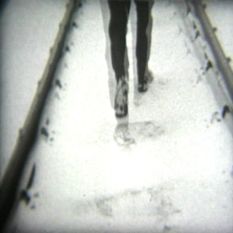


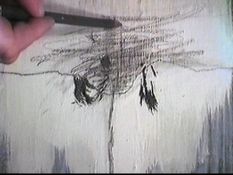

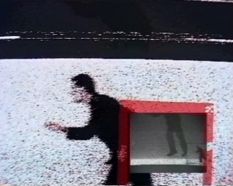

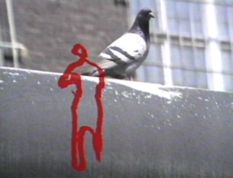
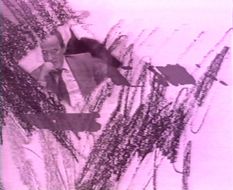
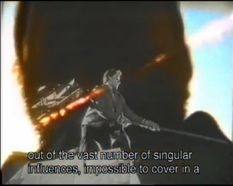

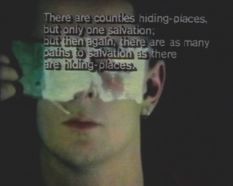
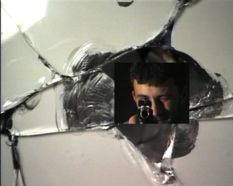
Invissible Parallel by Heiko Daxl | 1994 |
||
"You shall let go of the old, the old worn grinding, You shall grasp the present times." (from "IDENTITY" - a video by Antal Lux) |
||
Already our school mathematics have taught us that the terms indivisible and parallel are clear contradictions, as by definition not congruent. After the infinitesimal calculation we wonder that that a projection of a point into infinity can become a plane. And after Einstein´s theories and the fundamental changes of the structural concepts our practical trust into the categories of elementary sciences is shaken and is daily shaken further. Gradually the sciences are transforming the conventional view on our universe into a complex system of interdependencies, which is not only beyond the general understanding and description, but is rattling the basics of the absolute proof of mathematics and physics. Random, chance, dynamic erratic developments, instability or quite generally the dissolve from order to chaos are the synonyms for this confusion, a kind of Heisenberg´s ´relation of the unsharp´ of causality. The title Indivisible Parallel does not result out of this confusion of concepts (which was only thought of as an introduction), but on the special personality of Antal Lux, who in his art is uniting seemingly contradictionary elements of professions as a painter, a graphic-artist, sculptor, video-artist and especially human being to an indivisible parallelism of his identity. After his flight from Hungary, (also subject of a video work of the same name from 1983), after the suppressed rebellion of the revolution of 1956, he first came to southern Germany, where his artistic education and his further creative developments began. Even since this time, his attention has not been devoted to the perfection of one discipline only, to the concentration on one form of artistic expression. Here his search form a unity among the diversity of depictions has already begun. The swaying between representationalism and abstraction, between the moving and the static, his own history as frontier-crosser between east and west, the differences of experienced social systems, all this give hints to a polarization and a ´sitting between two stools´ in life and work of Antal Lux. No category or box can be found to fit him, because his work demands examination. Antal Lux holds no office, he is independent, a misfit, who after scratching at the surface of order, tries to give the discovered disorder a new form and a new content. He is not classifying, he rather declares his position and gives personal interpretations, which stand out well against the mounting array of answers. He does not want to give definite answers, rather nourish a debate of questions. "From a certain point there is no going back. That is the point to reach." (Franz Kafka in FRAGMENTS 1993) The beginnings of his occupation with the moving image date from the late seventies. Simple optical phenomena prompted him to experiment, first with the medium Super-8 film, and later with video. In CONTENANCE OR COMPOSURE IN A DIFFICULT SITUATION a videowork from 1983 he describes briefly and succinctly with quite simple means the discrepancy between his personal picture making and the conventions and heritage of film history. He ´shits´ in the truest sense of the picture on those conventions and so keeps his composure in a difficult situation. Antal Lux did not train as a video artist, but acquired step by step his technical possibilities and expanded his creative vocabulary. In the early, mainly graphic abstract works, he developed his language of form, which obviously refer to his previous artistic background, though already show a strong leaning towards time based media. The early works from the eighties are a direct transfer of graphical principles on the time-based planes. Often depicting a metamorphotic dissolving time, sound is still rather secondary compared to his later works. For example in HYDROGRAPHIC (1986), a line drawn in sand is again and again washed over by the waves, transformed in the moment of its creation into another state of matter, escaping the set frame, or breaking it up. CHOREOMANIA (1983) shows in one static take a dance of drawing pins. The very sparingly used subjects show up in ever new formations and seem to multiply by means of rhythmical dissolving. MANIPULATION (1984) takes the double meaning of its title literally: once as an artistic trick and secondly as a means of changing and influencing. Show-ing in an impressive way nothing else, but the manipulation of the written word Manipulation. KNIFE ON THE NECK OF THE NATION (1982) a kind of film/video/performance is shot in the hungarian countryside. From a flock of white geese, those ones are selected will later end as roast-meat. The chosen birds are dyed in the colors of the hungarian flag, plucked and finally slaughtered. The various stages are shown momentarily. Fast edited sequences and dissolves alternate. This parable about the ruler and the ruled however, did not bring down the wrath of the hungarian authorities, but resulted a censorship by the international league of animal protection during a screening in the Venice Biennal. Both GRIMACE (1983) and TRANSMIGRATION OF SOULS (1983) draw on the on the same recorded visual material. Both are also portraits of his wife Zsuzsa Dobai-Lux. In the first video he processes the images through painterly action and various lenses and mirrors. In PIANO LESSON, a short minimalistic, abstract work from 1989, he gives way to his ´tachistic´ playfulness on a keyboard and reduces a short piece for piano into a sequence of black/white/red forms and movements. HYPNOSIS (1993) on the other hand, proves that he has not been hypnotized by the fascination of the medium, but stresses the necessity of being alert and of responsible decision making. "The need to free oneself of all activity and the compulsion to make responsible decisions. As not all human beings develop (or preserve) this need to the same degree, some can be hypnotized easily, some superficially, others not at all." Radio-plays are the main focus of his work from middle of the eighties till the end of the decade. Yet the videos from this time are not a mere illustration of the model, but original versions by himself. The underlying stories of the radio-plays are not left untouched but treated as raw material and deconstructed. To quote freely from Goethe´s Faust "usually one believes after hearing only words, but with it one might also think something", fragmentary stories and moments from the historical fragments develop by the reorganization of the elements of the sound model, combined with his image constructions. In ELEVATOR TO PROMETHEUS (1986), to the composition of music by Heiner Goebbels and texts by Heiner Müller, he tries this style for the first time. As Prometheus questioned the order of the gods and manifested by his intervention the will to exist of the world and of human beings, Antal Lux intervenes in the course of events and frees himself by personal interpretation of the restrictions of the given text. UNKEPT SHORES (1987), as with the previous video based on works of the same author and composer, is captivating by its conventional accentuation and the discontinuity of image and sound. The repetition of sequences and the radical defamiliarization of "bobbing thoughts in muddy coastal waters, of flotsam of dead thoughts, and of brain-spawn" depicts, as metaphors of Medea´s inner and outside world, gloomy pessimistic scenarios and concepts of the world. In the end the question remains: "is this world, this landscape with Argonauts my world, Your world?" Antal Lux reads the texts cross-ways, breaks the flow of words and music and combines everything together with his video images to not necessarily linear meta-structures. "I do not try to illustrate a radio-play by the medium of video, as an artist I rather wish to depict the events as moving images, which takes a form of its own." THE GRASS AS IT GROWS (1988) is the free interpretation of Franz Mon´s radio-play of the same year. Neither the text nor the images tell a story, but are an alternating and swinging of processed images, taken from surrounds and from documentary material. Concrete moments, collaged images and historical events are highlighted, entwined with one another and faded to fragmentary strands. MAO´S BIBLE (1990) expresses again his fundamental skepticism and deep rooted doubts towards all totalitarian social systems and the paradigms of its prophets and helpers. According to Schiller´s postulate "One should ponder the voices", the content of Mao´s little red book is examined closely as a sarcastic visual comment. The video images grab fragments from phrases and nonsensical sentences of the Big Chairman and condense them into a new composed entity. Along with a text by the writer Wolf Wondratschek the tape WHITE THREAD (1992) describes stages of a car trip from Stuttgart to Berlin. The driver "sees various things, thinks various things, and thinks of various things", which appear fleetingly in short takes, while often text and image diverge widely to meet yet again in complex relations. As someone who has experienced that images and texts economically and emotionally have the power to deceive us, to blend, to please, and to elevate us, he watches the world with open eyes. In WALLRUNNER (1991) the Berlin Wall is the subject, which at the same time is used as a projection screen for a pas-de-deux. Two figures dance a ballet along the stages of history connected with the partition of the city. The wall as constantly present symbol of the partition, which limited every-day life in Berlin, was also a kind of wall news-sheet, a forum for articulation, where everyone who had something to say left their writings or graffiti, which as a living cross-section of opinions were commented on once more by others. Antal Lux is also such a commentator. The fall of the wall was also a big event for, and in the media, which transmitted the spectacle worldwide. IDENTITY (1991), is plumbing the depths of chance of ideas, which are determined by by culture, traditions and system of government. Those ideas and the roles the individual has to take or to play in society, determine the identity. The opening of the iron curtain has caused many ideas, and whole ideological concepts based on those ideas, to collapse. DEATH OF RAMS (1992), is again looking back on the history of the Berlin Wall. Antal Lux takes the graffiti "The Crazy Ones are always on the other side" as an opportunity to review, within his re-compilation of GDR TV history, the events of 30 years of Berlin Wall. The building, the pride, the cheering politicians, the oath of loyalty of the Stasi (Secret State Police) and ´the dying for the state´ are put through to video technical mincer, broken down into its individual constituents, recomposed new into vibrant montages, which breathe the last breathe of history. From its title, CASE (HI)STORY (1992) is ambiguous in its referring to remembrance of both, the events during the Hungarian people´s revolt of 1956 against the communist one-party government, and also the personal history of the author. As mentioned in other examples Antal Lux is also a curious person who sharpens his perception of the times and circumstances in which both he lives and works. In 1/61 CHAMISSOPLATZ, a work from 1993, he is tracking down subtle impressions of his immediate neighbourhood. Time-windows are opened and memories are triggered, curiosity, the fear of the unknown invading, and the longing for justice. Lux leaves time for himself and the viewer to see and listen, and interweaves layers of sound and images to a corresponding whole. The breaking glass, the secretive observing of the other, leaves in the wind and the dancing drunken woman and much more, are his seasonings of the cosmos he is outlining here. Like good food which he is appreciating very much, the ingredients are lavish like a meal in the Hungarian countryside. Yet is Lux, the Hungarian, not describing his identity as a Berliner ? But already in the following video BERLIN-CENTRAL from the same year, he is pointing out with self-confidence that his hometown Budapest should not be forgotten in the listing of cosmopolitan cities on billboards in a Berlin subway station. FRAGMENTS (1993) uses as a musical basis the composition of György Kurtag "Kafka Fragments" and gives preference to the written word over the spoken word. THE OATH, a work from 1994 shows the parades and the pathos of the GDR and the oath on the republic, but also rising of the 17th of June 1953, the build-ing of the wall in Berlin and the memory of slain fugitives. VOW, also 1994, condenses THE OATH to just over a minute. A spider´s web with two tender feathers still hanging in it, is superimposed over the images of the last fugitives before the build-ing of the wall, the vow of the German Democratic Republic, scenes which seem to be torn out from the book of history. The monitor-objects TWINKLE MY STAR, TWINKLE, THE ARMS OF THE PROLETA- RIAT HAVE PETERED OUT, "THE TIMES, THEY ARE CHANGING" and HUNGARIAN NOSTALGIA have an ironic look at the mass-media and the conveying of political messages in the former communist states. The empty casings of the TV-sets with shattered cathode-ray tubes, which can no longer picture the messages, remain over. A constant feature of his videos and his paintings is time and again the mutual influencing, supplementing and stimulating of one another. The development and transformation of an idea through various media is evident. So we discover his gesture in the MONITOR FLAGS since 1988, which take up the succession of video sequences and transfer them into a stability of hanging side by side. The collaging and layering of found materials and the individual arranging and revising can be found as a principle of form in his pictures, graphics and also in his videos. He models his video images like a sculptor, manually and in so doing makes them tangible. The video RESTLESS (1994), based on the musical composition by György Kurtag, is a continuation of the FRAGMENTS. As the earlier tape, the work has a very deep philosophical level. Even when the shadows of the man (Zbigniew Karkowski) are growing bigger and bigger, he cannot leave the ground he is bounded to. Ecstasy (John Duncan) might appear as an escape, an entering into different spheres. But is not this difference already existing in our reality ? When the woman (Zsuzsa Dobai) throws the stone, she might throw it as far as possible, but this distance is just a step to do. What has happen happened, always to late to regret. Everyone´s way of life is a task and a challenge. During a vist in Zagreb in summer 1994 he was searching for traces of the war, but couldn´t find direct influences in the moment. As a result of the fascination by the visual attraction of the brick wickerwork, but also emotial approach to the situation, the wall functions as a kind of "red thread" in the video´s concept. Lets now talk about the philosophy behind the pictorial library. Antal Lux does not use his scenes and images just once, he rather files them in an archive of pictures to use them again in another appropriate context. This is possible because his collection accumulates to a library of icons, which carry meaning and content within themselves, and represent the extended presence of the representation. In GLOSSOLALIE from 1991 he is tracing the phenomena of the ´tongue talking`, an articulation in unconnected, often unintelligible scraps of speech, which can occur in the stages of ecstasy or in cases of schizophrenia. The video itself is not only a commentary on his personal way of working, but a description of the spreading confusion in Germany after reunification. "In the struggle between Yourself and the world, side with the world." (Franz Kafka in FRAGMENTS 1993) He has not the supposed objectivity in his mind, but a way to draw his conclusions; that is a radical constructivism which makes him time and again find and invent new the essences of reality off the beaten track of formalism and well-trodden paths. Even when all his activities and gestures in parallel media and techniques seems to co-exist, they are ultimatively the expression of different facets in the mosaic of the indivisible artist´s personality Antal Lux, who in spite, or especially due to his broad mature work, has kept the freshness of experimental access, and with it the continuing challenge. Heiko Daxl | 1994 |